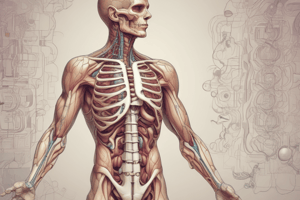Podcast
Questions and Answers
What is the function of the pharynx in relation to air and food?
What is the function of the pharynx in relation to air and food?
- It only conducts food and drink from the oral cavity to the oesophagus
- It only conducts air from the nose to the larynx
- It conducts both air from the nose to the larynx and food and drink from the oral cavity to the oesophagus (correct)
- It is only responsible for producing saliva
What is the main function of the constrictor muscles in the pharynx?
What is the main function of the constrictor muscles in the pharynx?
- They help in swallowing food
- They produce saliva
- They help in breathing air
- They form the wall of the pharynx (correct)
What is the function of the hard palate in the mouth?
What is the function of the hard palate in the mouth?
- It produces saliva
- It is involved in the digestion of food
- It conducts air from the nose to the larynx
- It separates the mouth cavity from the nasal cavity (correct)
What is the name of the tube that extends from the base of the skull to the lower border of C6?
What is the name of the tube that extends from the base of the skull to the lower border of C6?
What is the name of the muscle that forms the tongue?
What is the name of the muscle that forms the tongue?
What are the three pairs of salivary glands located on each side of the body?
What are the three pairs of salivary glands located on each side of the body?
What is the length of the oesophagus?
What is the length of the oesophagus?
At what level does the oesophagus pierce the diaphragm to enter the abdomen?
At what level does the oesophagus pierce the diaphragm to enter the abdomen?
What is the name of the orifice that communicates between the oesophagus and stomach?
What is the name of the orifice that communicates between the oesophagus and stomach?
What forms the right border of the stomach?
What forms the right border of the stomach?
Flashcards are hidden until you start studying
Study Notes
Digestive System
- Stomach:
- Fundus: dilated part above an imaginary transverse line passing by the cardiac orifice
- Body: located below the fundus
- Pyloric portion: composed of pyloric antrum, pyloric canal, and pylorus (surrounded by thick pyloric sphincter)
- Small Intestine:
- Long, convoluted tube (about 6 meters long) extending from the pylorus to the ileo-cecal valve
- Parts:
- Duodenum (2 inches)
- Jejunum (proximal two-fifths)
- Ileum (distal three-fifths)
- Large Intestine:
- Extends from the ileum to anus
- Parts:
- Cecum
- Appendix
- Ascending colon
- Right colic flexure (hepatic flexure)
- Transverse colon
- Left colic flexure (splenic flexure)
- Descending colon
- Sigmoid colon
- Rectum
- Upper part of anal canal
Appendix
- Worm-like structure, 2-20 cm long, arising from the postero-medial part of the caecum
- Positions:
- Retrocecal (65%)
- Pelvic (30%)
- Subcecal (3%)
- Pre or post-ileal (2%)
- Surface anatomy: base of the appendix lies at the Mc Burney's point (junction of the upper 2/3 and lower 1/3 of a line extending from the right anterior superior iliac spine to the umbilicus)
Anal Canal
- About 4 cm long
- Begins as a continuation of the rectum and terminates at the anal orifice
- Controlled by two sphincters:
- Voluntary sphincter (external anal sphincter, supplied by the pudendal nerve)
- Involuntary sphincter (internal anal sphincter, supplied by autonomic nerves)
Liver
- Composed of two big lobes: right and left lobe (right lobe is larger)
- Lobar separation by the falciform ligament
- Porta hepatis (hilum of the liver):
- Contains the portal vein, hepatic artery, and hepatic ducts
- Also contains lymph nodes and sympathetic plexuses
- Blood supply: receives blood from the hepatic arteries and portal vein
- Venous drainage: through three hepatic veins terminating in the IVC
Biliary System
- Consists of:
- Gall bladder
- Biliary ducts
- Gall bladder:
- Pear-shaped sac
- Lies in the "gall bladder fossa" on the inferior surface of the liver
- Parts: fundus, body, neck, and cystic duct
Studying That Suits You
Use AI to generate personalized quizzes and flashcards to suit your learning preferences.




